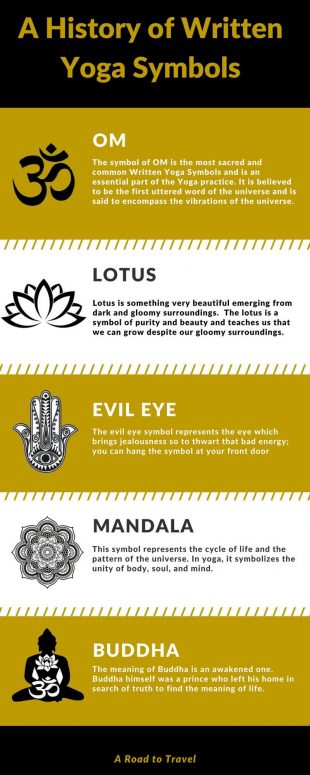The history of Yoga Symbols: We find that man has used & drawn symbols as far back as to the cave paintings from millions of years ago. Some are religious, some are emotional but all types play a role in our humanity. The same is with Yoga, the symbols all have a meaning and can be used for your daily yoga as motivational tools.
Introduction
First mentioned in ‘Yoga Sutra’ written by an Indian sage Patanjali, Yoga is an ancient Indian art originated around 5000 years ago and focuses on harmonizing mind body and spirit. It is not a religion but an art of living.
While learning about Yoga and reading a Yogic text, we come across various written yoga symbols which we find intriguing. Each of these symbols has a unique history and importance in the Yogic parlance. If you want to excel the art form, you should learn about the history of Yoga symbols and their significance.
The History of Yoga Symbols
Yoga is a practice which unites you with your inner self, the subconscious. Diving into the mystery, meaning, and history of Yoga symbols can add new depth and perspective to your endeavors.
The ancient sages or Rishis (as they call them in India) took inspiration from the environment as well as animals, plants birds, and other creatures to symbolize a particular asana. Even many asanas were named after creatures and plants like Sinmhasana (the lion posture) Tadasana (the Tad tree), and Mandookasana (the Frog pose).
How do they help in Meditation
Meditation brings your mind, body, and soul into a state of peace and serenity by connecting you with your subconscious self. It takes great time and effort to excel the art of meditation because we are not aware of the symbolic language.
By decoding written yoga symbols you can quickly learn how to meditate like a pro and gain the best of it. While doing meditation, you can certainly connect with the Seven Chakras of the body. Each chakra has its own symbol, color, and meaning.
Meditation lets you be aware of the energy that is flowing through these chakras. Focusing on these symbols shall definitely let you connect with nature and with your own inner self.
What do the Symbols Mean?
In learning the history of Yoga symbols, we see that each symbol associated with the Yoga posture has a unique meaning or association with nature. Primarily, there are three types of Written Yoga Symbols.
Yoga postures themselves are symbols. They are often related to nature and living beings. Examples include the Mayurasan (Peacock), Bhujangasana (Snake), and Padmasana (Lotus). There is also the Bakasana (Crane), Suryanamaskar (sun salutation) and the Garudsana (Eagle).
Symbols written in ancient Sanskrit – Most revered symbol in yoga is of OM’. When you chant Om, you feel connected with the universe and a feeling of oneness encompasses you. It is best to recite OM’ during the meditation phase. It is recited by starting from the back of the throat, then moving to the palate and finally close with an mmm’ sound.

Seven Chakras of the body
Chakras are energy centers of the body and they are seven in numbers.
Chakra 1 – Muladhara: It is the first chakra and located at the base of the spine. The color of this chakra is red and it represents the root of your body and gives a sense of safety.
Chakra 2 – Swadhisthana: It is the second chakra and it is centered on the hips. Intimacy, family, and recreation are attached to this chakra.
Chakra 3 – Manipura: It is our center of power and it is near the navel. It is where we find our core power and balance the power with compassion.
Chakra 4 – Anahata: This chakra is found at the heart center and is one of the central chakras of your body. It bridges the power and creativity of your body.
Chakra 5 – Visuddha: It is located near the throat and it is concerned with the creativity and communication with the world.
Chakra 6 – Ajna: This is the sixth chakra of your body and often referred to as the third eye. It is found on the forehead between both the eyes. It is the chakra where our knowledge and conscience stem. This is the chakra to focus on while meditating.
Chakra 7 – Sahasrara: This final chakra of your body is represented as a lotus. It is the crown of the head and it connects you with the universal consciousness.
Why are the symbols important in my life?
The written yoga symbols not only depict the essence of each posture but are of prime importance as they represent the phases of life from childhood to youth to death.
The seven chakras move from the base to spine to the crown in the same way as life progresses from childhood to adulthood to death. When the symbol of OM is recited, you feel a oneness with the universe.
Yoga Symbols
Top Five Most Common Yogic Symbols and Their Meaning
OM: The symbol of OM is the most sacred and common Written Yoga Symbols and is an essential part of the Yoga practice. It is believed to be the first uttered word of the universe and is said to encompass the vibrations of the universe. The pronunciation itself is divided into three stages of Awake, Asleep and everything in between. O is the stage of awakening, U is the stage of dreams and M is the stage of deep sleep.
Lotus: Lotus is something very beautiful emerging from dark and gloomy surroundings. Padma’ (Lotus in Sanskrit) represented in a very important asana Padmasana’ is considered as a typical signature posture of a Yogi. The lotus is a symbol of purity and beauty and teaches us that we can grow despite our gloomy surroundings.
Hamsa and the Evil Eye: The term Hamsa refers to five fingers and is drawn as right-hand palm open. This symbol is considered to bring luck as well as protection and strength. The evil eye symbol represents the eye which brings jealousness so to thwart that bad energy; you can hang the symbol at your front door.
Mandala: Literally the word Mandala’ refers to a circle in Sanskrit. This symbol represents the cycle of life and the pattern of the universe. In yoga, it symbolizes the unity of body, soul, and mind.
Buddha: The meaning of Buddha is an awakened one. Buddha himself was a prince who left his home in search of truth to find the meaning of life. He is a symbol of a person who liberated himself of the suffering and entanglement of life. This symbol represents compassion and openness.
Conclusion
The written yoga symbols are important for everyone who practices yoga in any form whether to heel the body or the surroundings. These symbols symbolize the essence of human life itself and let you reconnect with nature and the universe at large.






